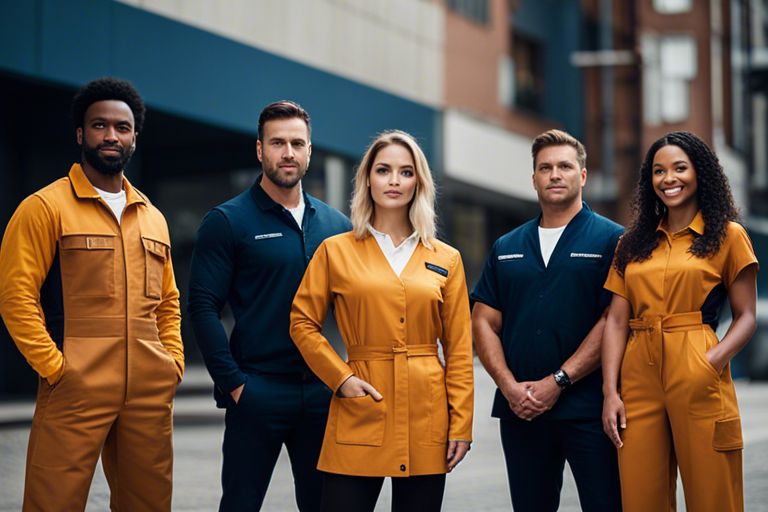
By flokmarketing | March 31, 2024
With workwear and uniforms being necessary in various industries, it’s crucial to understand the distinctions between the two. Workwear is primarily focused on functionality, providing comfort, protection, and ease of movement for individuals in demanding roles. It includes items such as coveralls, cargo pants, safety vests, and durable jackets, all designed to withstand the wear and tear associated with challenging tasks.
On the other hand, uniforms are aimed at creating a standardized and professional appearance within specific organisations or industries. They foster a sense of unity and professionalism, helping individuals identify with their roles and enhancing brand recognition. Uniforms are more formal in appearance, with consistency in design, colour, and style, and are often associated with industries where a professional image is vital, such as hospitality, aviation, and customer service.
Key Takeaways:
- Workwear: Designed for functionality, comfort, and protection for various industries and professions.
- Uniforms: Aim to create a standardised and professional appearance to foster unity and brand recognition.
- Differentiation: Workwear prioritises practicality and individuality, while uniforms focus on consistency and formal professionalism.
The Origins of Workwear and Uniforms
Historical Perspective of Workwear
Workwear: Some historical perspective reveals that workwear has been tailored to meet the specific needs of various industries. Over the years, it has evolved to prioritise functionality, durability, and protection for workers in physically demanding jobs. From the sturdy coveralls of the industrial revolution to the high-visibility vests of the modern construction site, workwear has always been about equipping individuals with the necessary gear to perform their tasks safely and efficiently.
Development of Uniforms Throughout the Years
Origins: Some significant developments have shaped the evolution of uniforms across different sectors. From military regalia to corporate attire, uniforms have played a pivotal role in creating a sense of identity, professionalism, and unity within organisations. The standardisation of uniforms has helped to establish a consistent brand image and foster a cohesive team spirit among employees.
Uniforms: The development of uniforms throughout history has not only focused on creating a unified appearance but also on reflecting the values and ethos of the organisations they represent. Uniforms have become a symbol of authority, expertise, and dedication, impacting how individuals are perceived in their respective roles.
Functionality and Practicality of Workwear
Design Features that Enhance Job Performance
Features of workwear are specifically designed to enhance job performance and ensure the safety and comfort of individuals in demanding environments. Any workwear is crafted with durable materials that can withstand the wear and tear associated with various industries, such as construction and healthcare. These materials provide protection against elements like dirt, chemicals, and abrasions, allowing workers to focus on their tasks without worrying about their clothing.
Industry-Specific Workwear Requirements
Performance in the workplace is greatly influenced by industry-specific workwear requirements. Different sectors have unique demands, and workwear must meet these needs to ensure optimal safety and efficiency. Understanding these industry-specific requirements is crucial for selecting the right workwear that can withstand the challenges of the job. For example, protective workwear in the healthcare industry may include features like fluid-resistant fabrics and antimicrobial properties to maintain a hygienic environment.
Standardization and Professionalism in Uniforms
After exploring the functionality and practicality of workwear, it’s important to probe into the world of uniforms. Uniforms play a crucial role in standardising the appearance of individuals within an organisation or industry, creating a sense of unity and professionalism.
The Role of Uniforms in Creating Corporate Identity
Creating a distinct corporate identity is crucial for businesses to stand out in today’s competitive market. Uniforms help employees identify with their organisation, enhance brand recognition, and foster a sense of belonging to a cohesive team. By standardising the appearance of employees, uniforms can reinforce the company’s values and project a professional image to customers and clients.
Psychological Impact of Uniforms on Employees and Customers
IdentityUniforms can have a significant psychological impact on both employees and customers. For employees, wearing a uniform can create a sense of belonging, pride, and professionalism. It can also help in fostering a team spirit and promoting a positive work environment. On the other hand, customers often perceive uniformed employees as more credible, knowledgeable, and trustworthy, leading to increased customer satisfaction and loyalty.
StandardizationUniforms eliminate individual fashion choices and ensure a consistent and professional appearance across all staff members. This standardisation not only enhances the organisation’s brand image but also promotes a sense of unity and belonging among employees, ultimately contributing to a more positive work culture.
Variations in Design and Material
Materials Used in Workwear for Durability
Workwear is crafted using high-quality, sturdy materials to ensure durability in demanding work environments. This includes materials such as rugged cotton, durable polyester blends, and abrasion-resistant fabrics. These materials are chosen specifically for their ability to withstand wear and tear, providing comfort and protection to individuals across a range of industries. The emphasis on durability in workwear materials is crucial for ensuring longevity and functionality in the garments.
Aesthetic Considerations in Uniform Design
On the other hand, uniform design places a significant focus on aesthetic considerations to create a cohesive and professional appearance. This includes elements such as colour coordination, logo placement, and design consistency across all team members. Aesthetics play a key role in enhancing brand recognition and promoting a sense of unity within the organisation. The meticulous attention to detail in uniform design helps establish a visually pleasing and identifiable look that reflects the values and professionalism of the company.
As far as uniform design, the impact of aesthetics goes beyond just appearances. A well-designed uniform not only reinforces brand identity but also contributes to employee morale and customer perception. By carefully considering colour schemes, fabric choices, and style elements, organisations can create uniforms that not only look good but also make a positive impression on both employees and customers.
Branding and Personalization
Workwear Branding Techniques
An necessary aspect of workwear is the ability to incorporate branding and personalization to create a professional and cohesive appearance. Branding techniques such as embroidery, screen printing, and custom labels can help companies showcase their logo and identity on workwear, enhancing brand recognition and employee pride. These techniques not only promote the company’s image but also provide a sense of unity among employees, fostering a strong team spirit.
Visual Cohesion Through Uniform Branding
An important element of creating a unified and professional look within a workplace is through visual cohesion achieved by uniform branding. By implementing consistent colours, logos, and styles across all uniforms, organisations can project a polished and cohesive image to customers and clients. This visual consistency not only enhances the company’s brand but also reinforces a sense of professionalism among employees, contributing to a positive work environment.
Workwear plays a crucial role in not just providing functionality and protection but also in visually representing a company’s brand and creating a sense of identity and unity among employees.
Compliance and Regulations
Safety Regulations Impacting Workwear Selection
With safety being a paramount concern in various industries such as construction, manufacturing, and healthcare, it is crucial to adhere to safety regulations when selecting appropriate workwear. The Health and Safety Executive (HSE) guidelines, for example, dictate requirements for protective clothing, footwear, and visibility aids to ensure the well-being of workers. Failure to comply with these regulations can result in serious injuries and legal repercussions.
Legal Aspects of Uniform Implementation
Any organisation implementing uniforms must be aware of the legal considerations surrounding their implementation. From ensuring non-discriminatory policies to handling uniform expenses, there are various legal aspects to consider. It is important to have clear policies in place to address issues such as uniform maintenance, replacement, and employee rights related to wearing uniforms.
It is vital to understand that uniforms can serve as a symbol of professionalism for the organisation, but incorrect implementation can lead to dissatisfaction among employees. Therefore, regular reviews and updates to uniform policies are necessary to ensure compliance with legal obligations and employee satisfaction.
Care and Maintenance
Best Practices for Maintaining Workwear
Once again, caring for your workwear is vital to ensure its longevity and effectiveness on the job. To maintain your workwear, it is important to follow some best practices. On a regular basis, check for any tears, wear, or damage to your workwear to address any issues promptly. Wash your workwear according to the manufacturer’s instructions to preserve its quality and functionality. Proper storage, such as hanging or folding your workwear correctly, can also help maintain its shape and condition for longer.
Ensuring Longevity and Appearance in Uniforms
Once again, uniforms play a key role in creating a professional and cohesive appearance for individuals within an organisation. On top of regular maintenance, it is crucial to pay attention to the longevity and appearance of uniforms. Investing in high-quality materials and construction can ensure the durability and appearance of uniforms over time. Proper care, such as following washing and ironing instructions, can help maintain the crisp and polished look of uniforms.
Understanding the importance of maintaining uniforms can contribute to a positive brand image, professionalism, and employee morale.
Impact on the Workforce
Shifts in Employee Morale Due to Workwear and Uniforms
With workwear being tailored for specific tasks and uniforms promoting a sense of unity, the choice of clothing in the workplace can have a significant impact on employee morale. Research has shown that employees who are provided with comfortable and practical workwear tend to feel more valued and motivated in their roles. On the contrary, rigid uniform policies may lead to feelings of restriction and conformity among the workforce.
Balancing Employee Comfort with Professional Standards
An important consideration when implementing workwear or uniforms is striking a balance between employee comfortand maintaining professional standards. While workwear prioritises functionality, uniforms emphasise a uniformed appearance. However, organisations can enhance employee satisfaction by choosing workwear that combines comfort with the necessary level of professionalism. This can contribute to increased workplace productivity and a positive company culture.
Employee satisfaction is crucial for the overall success of a business, and the choice of workwear or uniforms can influence employee engagement and loyalty towards the organisation.
Cost Considerations
Analyzing the Cost of Investing in Workwear
Many companies underestimate the significance of investing in workwear that is tailored to the specific needs of their workforce. However, it is crucial to consider the long-term benefits that high-quality, durable workwear can provide. By choosing workwear that prioritises functionality and durability, companies can reduce the frequency of replacing damaged or worn-out clothing. This not only saves costs in the long run but also enhances the safety and comfort of employees, potentially reducing workplace accidents and injuries.
Financial Implications of Supplying Uniforms to Employees
Financial considerations play a significant role in the decision-making process when it comes to supplying uniforms to employees. While uniforms can create a sense of unity and professionalism within a workforce, the initial investment and ongoing maintenance costs must be carefully evaluated. Companies need to assess the cost-effectiveness of supplying uniforms in relation to the benefits they bring, such as enhanced brand recognition and a cohesive team identity.
Providing uniforms to employees can be a practical and cost-effective solution in industries where a professional appearance is important, such as hospitality and healthcare. By investing in high-quality uniforms, companies can enhance their brand image and create a sense of unity among employees, ultimately leading to improved customer satisfaction and loyalty.
Future Trends and Innovations
Technological Advancements in Workwear Fabrication
The technological advancements in workwear fabrication have revolutionised the industry, making it safer and more efficient for workers across various sectors. The use of advanced materials such as flame-resistant fabrics and moisture-wicking textiles has significantly enhanced the protective qualities of workwear. Innovations in nanotechnology have also allowed for the creation of fabrics that are not only durable and comfortable, but also resistant to harmful chemicals and extreme conditions.
The Evolution of Uniform Styles in the Modern Workplace
Despite the traditional image of uniforms, they have undergone a significant evolution in the modern workplace. Anyincreased focus on employee wellbeing and comfort has led to the incorporation of ergonomic designs and breathable fabrics in uniform styles. Customisation options have also become more prevalent, allowing organisations to showcase their branding while still maintaining the professional image associated with uniforms.
Workwear has truly evolved from being just functional clothing to incorporating cutting-edge technologies that enhance safety and performance in the workplace.
Choosing Between Workwear and Uniforms
Not sure whether to opt for workwear or uniforms? Explore the differences further in our article What is difference between workwear and Uniforms in clothing for a comprehensive understanding of each.
Factors Influencing the Decision Process
- When deciding between workwear and uniforms, several factors come into play. Consider the industryrequirements, the nature of the job, as well as the desired level of professionalism.
- The cost-effectiveness and durability of the clothing items must also be taken into account. Comfort and safety features are vital considerations to ensure the well-being of the wearers.
With the right considerations, the appropriate choice between workwear and uniforms can be made to suit the unique requirements of the workplace.
Case-by-Case Analysis for Optimal Clothing Solutions
An in-depth analysis is crucial when determining the most suitable clothing solution for a specific setting. For instance, in hazardous environments, workwear with protective features may be crucial to minimise risks to workers.
Final Words
Summing up, the distinction between workwear and uniforms lies in their intended purpose and design. Workwear prioritises functionality, durability and comfort, catering to a diverse range of industries. On the other hand, uniforms are aimed at creating a standardised appearance within organisations, promoting professionalism and team unity. Workwear allows for personalisation and practicality, while uniforms focus on a polished and formal look. Ultimately, the choice between workwear and uniforms depends on the nature of the job, industry requirements and desired level of standardised appearance.
FAQ
Q: What is the difference between workwear and uniforms?
A: Workwear is designed primarily for functionality, providing comfort and protection for specific tasks, whereas uniforms focus on creating a standardised appearance within organisations.
Q: How do workwear and uniforms differ in terms of design and functionality?
A: Workwear varies in design and features to meet job requirements, made from durable materials for protection. Uniforms, on the other hand, have a consistent look to promote unity and professionalism.
Q: In what industries or professions are workwear and uniforms typically associated with?
A: Workwear is common in construction, manufacturing, healthcare, etc., while uniforms are prevalent in hospitality, aviation, healthcare, service sectors where a polished appearance is vital.




